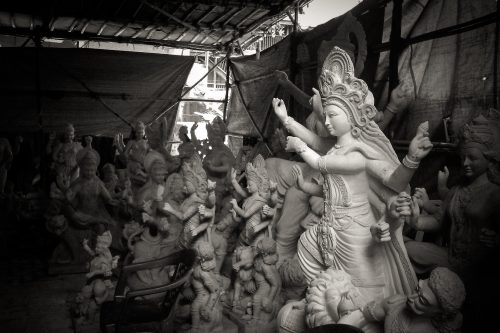Voices from the past
In couplets written in the 15th century, the mystic and humanist poet, Kabir, describes how his heart cries out when he sees temple priests worshipping stone images of gods while turning away from living beings made by the very same gods; and when he finds the muezzin inviting believers to prayers while shunning kaffirs (a derogatory term for non-Muslims) who are, after all, creations from the same soil of the one earth and descendants of Adam, our common Biblical first father.
Kabir is said to have been born of a Brahmin woman and brought up by a couple of poor Muslim weavers. Barred from entering a mosque or a Hindu temple, he remained an anomaly, an exclusion, caste-less, an outsider. Even after his death, after he was accepted and idolized as a great saint, with his verses sung at satsangs or religious gatherings, there were passionate disputes on whether to bury him as a Mussalman or cremate him as a Hindu. There is his oft-quoted verse from the Guru Grantha (religious scripture of the Sikhs):
“We have all imbibed light from the one Allah
And are all created alike from the same universal Nature.
So why do we call some good and others bad?”
Other philosophers, poets and writers have echoed Kabir’s thoughts. Nazeer Akbarabadi (Wali Muhamad), 18th-century poet, writes for the masses. “Wild, inconsistent, huge like nature itself, at times crude, impure, filthy like the slums of the wretched” – these are the terms he chooses when he sings alike of “the Hindu and Muslim festivals.” His caste is of joy, “his religion a universal sympathy.” Shams Tabrez, 13th-century spiritual instructor of Maulana Jalaluddin Rumi from Persia, sings:
“I know not my name nor caste nor colour nor creed.
Tell, me, O Mussalmans, tell me! Who am I?
I know not who I am.”
In more modern times, Mohammad Iqbal’s verses reflect the grandeur of Moslem simplicity of faith and character while he bows before the mazars (mausoleums) of saints like Chisti, Tabrez and Juned:”
“I will un-Moslemize ye by my song, O Moslems! If ye think your neighbour is other than yourself.”
And Yone Noguchi in early 20th century Japan is delighted that Japanese poetry embodying Buddhist thought is not “tormented by religion:”
“Oh! How cool
The sound of the bell
That leaves the bell itself.”[1]
Although today these beautiful words, folk rhythms and repetitions sound pleasing to the ears, and the simple questions they raise are disturbing enough to make people stop and think, “Sufi” (pertaining to Sufism, the inner or mystical aspect of Islam) has become a popular genre of music. This is clear from Bollywood, India’s massive Hindi film industry that churns out one song “in Sufi style” after another: versions of Amir Khusro’s Mast Kalandar or Bulleh Shah’s Dance of the Kamli: [2]
“The Hajjis visit Mecca to perform Hajj
But I am Heer, and my Mecca is Ranjha
Who has renounced the world for me!
I have lost my mind, and like a Kamli
I dance in the frenzy of love.”[3]
Alliances that create fear and violence
Regardless of this mesmerizing enchantment with music and verse, things have not changed. Even today, after 700 years, Kabir’s kaffirs and the dalidars (soiled ones) are never quite accepted, although lip service is constantly being paid to his words and those who sing them. Why is this so? Why is it that while almost all religious texts honour human values of inclusion, empathy, kindness and compassion, the practice of the official interpreters of these religions proves otherwise? Since the very beginning, leaders have used religion as an easy and effective tool to control masses, instill fear, hatred, vengefulness, communalism and violence, and build powerful alliances with the “unholy.”
For example, Yogi Adityanath, current Chief Minister of the most highly-populated state of India, head priest of the Gorakhnath Hindu Temple, leader of youth vigilante anti-minority groups, links himself with Kabir and Buddha. The Temple itself is known for its militancy and religious dominance. Its former head priest, Digvijay Nath, was arrested for “exhorting Hindu militants to kill Mahatma Gandhi days before he was shot. His successor, Mahant Avaidyanath, urged Hindu mobs in 1992 to tear down a 16th-century mosque and build a temple there, setting off some of the bloodiest religious riots in India’s recent history.” And Adityanath is now spearheading the cause of a national Hindu state.
https://www.nytimes.com/2017/07/12/world/asia/india-yogi-adityanath-bjp-modi.html

“The World comes to my front door” by Caribb. Photo taken from flickr under Creative Commons license: CC BY-NC-ND 2.0
Here in Québec, Alexandre Bissonnette, a 27-year-old student from Laval University, is suspected of having attacked and shot six victims at the mosque in Sainte Foy. Mosques in Calgary, Montréal and Ottawa have been targeted and vandalized. On an average in the US, nine mosques per month have been attacked so far in 2017, and efforts have been made to deny zoning permits for the construction of religious facilities.
http://www.cnn.com/2017/03/20/us/mosques-targeted-2017-trnd/index.html
https://www.aclu.org/map/nationwide-anti-mosque-activity
In Europe, populations are seething. According to the 2017 European Union Terrorism Situation and Trend Report, “while the EU is facing a range of terrorist threats and attacks of a violent jihadist nature, from both networked groups and lone actors,” there have been more than “400 anti-Muslim hate crimes reported representing a 223 per cent increase.” In Germany, the number of racially motivated attacks has been higher than any year since the end of World War II. People aligning themselves with religious ideologies play a major role in fuelling this rage, while the principles of charity, love, social good, prayer, kindness and forgiveness are sacrificed before the altars of greed and hatred.
Gender inequalities
When it comes to sexuality, the practice of most religions has been to take a negative view outside the parameters of the growth of the family. Havva or Eve, the first woman, is blamed for having coaxed Adam into eating the forbidden fruit, resulting in man’s fall from grace. Woman, with her femininity and seductive powers, is stereotyped across world religions and cultures as the eternal temptress, the manipulative Delilah, Salome, Jezebel, Kaikeye, able to throw the powerful off guard and come through triumphant in an unholy alliance with eternal damnation. Preoccupation with carnal thoughts has been considered a dangerous distraction for rishis (sages) such as Vishwamitra, whose power of deep meditation, seen as a threat by Lord Indra, was disrupted by the appearance of the beautiful apasara (heavenly maiden), Menaka, skilled enough to successfully lure Vishmamitra away from his divine focus.
Although Hindu scriptures pay high tribute to the ever-sacrificing mother figure, Devi (the goddess in her many forms, including that of Shakti, representing strength), socio-cultural norms bolster religious leaders in demanding more from the woman, and placing greater pressure on her to abstain, nurture, accept and preserve moral values. Hindus argue that their ancient texts grant Kama or sensual desire as one of the four principal objectives in life, a kind of offering, meditation or enlightenment, but it is far from what is practiced. This reluctance to accept sensual desire, and the promotion of celibacy for orders of monks and priests, often lead to aberrations and secret exploitation of those placed in their trust.
Alliances that encourage exploitation, fear and violence
Men and women of God take a pledge of poverty, chastity and obedience, and live in an environment of gender segregation to maintain chastity and prevent transgression. In the process however, this life of repression has the opposite effect, and the very segregation intended to be conducive to chastity ends up leading to secrecy, exploitation and an unspeakable breach of trust. In the early part of the 19th century, thousands of Indigenous children in Canada were sent to Residential Schools run by Christian orders of priests and nuns. It has now been confirmed that many of these children faced sexual abuse of the worst kind. Phil Fontaine, the former National Chief of the Assembly of First Nations, claims that “In my grade three class, if there were 20 boys, every single one of them would have experienced what I experienced. They would have experienced some aspect of sexual abuse.”
https://en.wikipedia.org/wiki/Catholic_sexual_abuse_cases_in_Canada
In Ireland, over 4,000 priests and deacons in active ministry between 1950 and 2002 have been plausibly accused of the sexual abuse of a youth under the age of 18. In one report, “four Dublin archbishops were found to have effectively turned a blind eye to cases of abuse from 1975-2004.”
https://en.wikipedia.org/wiki/Catholic_Church_sexual_abuse_cases
Official apologies have ensued. In 2008, the prime minister of Canada, Stephen Harper, announced that “the treatment of children in Indian Residential Schools” run as “joint ventures” with Anglican, Catholic, Presbyterian or United Churches, “is a sad chapter in our history.”
In 2015, Pope Francis met with victims, and expressed his profound sorrow for the suffering of those who were abused by Catholic priests. Earlier, in 2014 he had condemned the Church’s handling of abuse, saying that the failure to respond to reports of abuse by pedophile priests had caused “even greater suffering” to victims. Our fear to expose what is considered holy and pure is the primary reason why it has taken over 100 years to acknowledge the shameful past of our government-led religious and educational institutions.
https://www.theguardian.com/world/2015/sep/27/pope-francis-sex-abuse-scandal-survivors
The above statistics are hard to believe, but this is thanks to an international network of schools and institutions set up by Christian missionaries, making it easier to scrutinize, especially after exposure of the first such scandal. We do not have the same kind of statistics for godmen from other religions, but this does not mean that they do not exist or that things are any different. In India, for example, there have been many accusations. Some have resulted in convictions, but many are never brought before the courts. Asaram Bapu, also known as Bapuji, is one such godman. With a large following and a list of 400 ashrams (religious sanctuaries) both in India and abroad, he was arrested in 2013 for allegedly raping a 15-year-old girl who lived close to one of his ashrams. In the same year, Mahendra Giri, or Tunnu Baba, was arrested for confining and raping a young woman over a period of four months. Baba Gurmeet Ram Rahim Singh, a godman-cum- actor, director and musician who is said to have turned 60 million souls toward “God Realization,” was charged in 2007 and convicted in 2017 for rape and criminal intimidation.
http://www.cnn.com/2017/08/28/asia/guru-india-rape-sentencing/index.html
http://www.dw.com/en/the-dark-side-of-indias-self-styled-godmen/a-38957408
From the gates of despair
“Never again” is what we often say, but the mesmerizing power of the “sublime” becomes difficult to resist even when its lure is aligned with the depths of evil. In 1978, Jim Jones, the self-acclaimed apostle of the People’s Temple of the Disciples of Christ (religious sect formed in 1955), was able to convince 909 people to kill their children and themselves by ingesting Kool-Aid laced with drugs, including Valium and cyanide. “It’s not worth living like this,” he says in the last audio recording before the massacre. “We win when we go down…. I cannot separate myself from the pain of the people…. I like to choose my own kind of death…. I’m the best friend you’ll ever have…. I have always taken your pains on my shoulders….We all crave for peace…. I practically died to give you peace….We are done in as far as any other alternative…You’ll regret it if you don’t die…. We are born before our times…. We are not committing suicide. It is a revolutionary act… We lay down our lives in protest of what’s being done!”
“Let’s make it a beautiful day!” says one from the congregation. “We are all ready to go!”
https://archive.org/details/ptc1978-11-18.flac16
We seek comfort by convincing ourselves that we are none of these. We are the rational and sensible ones with access to almost every piece of information over the Internet. We are intelligent, sentient beings. But even today, as I listen to the Jonestown “Death Tape,” I am disturbed to find myself beginning to understand how someone like Jim Jones could wield such magical thrall. There is the fire and fury we seek to reach, passionate heights or depths of destruction, unimaginable, unprecedented! We can still be moved to place our senses and reasoning in the hands of one or a few, and we can still find support for rallies against non-white, non-Christian populations, leading a death march the likes of which the world has never seen before.
I turn to Bulleh Shah’s simple verses, and it feels good to see how they have grown to become a part of the nation’s cultural fabric. Yet once the concerts are over and the microphones and headsets are turned off, mobs go back to pursuing, harassing, and at times, lynching those who feed on the sacred Hindu cow.
“Why do you fight with the devil outside
Without ever wrestling with the devil within?”
or
“Go ahead and bring down all places of worship,
The Temple and the Masjid!
Go ahead and break down all that can be broken!
But spare the hearts of people,
For that is where God lives.”
[1] The Spirit of Oriental Poetry by Puran Singh, London: Routledge, 1926
[2] Amir Khusro was a 13th-century poet, and Bulleh Shah, a 17th-century Muslim Sufi poet from Punjab.
[3] Heer (and Ranjha), a romantic Punjabi legend immortalized by the 18th century poet, Waris Shah, in which the search for love is portrayed as an ultimate sacrifice (fana) of one’s body and soul.









